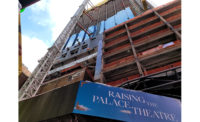What was the biggest challenge for One Clinton, the $280-million combination library and luxury condominium project in Brooklyn? You could call it “the hole story.”
Workers had to excavate 50 ft at the site—shaped like Manhattan’s Flatiron building and near the foot of the Brooklyn Bridge—going that deep to avoid putting pressure on adjacent No. 2 and No. 3 subway tunnels. That effort alone took about six months to complete before the rest of construction could begin in earnest.
“It took so long to get down there,” says Karen Hu, a director at building owner Hudson Cos. and project manager for One Clinton, which replaces the old Brooklyn Heights library branch near Cadman Plaza. “When you remove the soil, you have to make sure you don’t disrupt the structural integrity of the tunnels. Imagine if a piledriver would dig into a tunnel and make it collapse!”
The library portion of the structure will stand three stories, with the 36-story, 134-unit condo tower on top. There'll be a terrace above the part of the library that isn't under the condominiums, and at or above that level will be a fitness room. The development will also include a 26th-floor sky lounge, a few small retail spaces at ground level, three levels of underground parking and car elevators.
What’s essentially a combination government, residential and commercial project meant a variety of design solutions throughout the flat-plate concrete structure.
“The structure behaves differently when subjected to lateral loads,” says Joe De Nardis of De Nardis Engineering, the project’s structural engineer. “It’s inherently more flexible at the northern end,” the “prow” of the footprint, which is less than 18 ft in width compared with 102 ft on the southern end.
De Nardis also explains the excavation challenges in detail: “You’re installing soldier piles into the ground before you start digging. Then you start digging and install the lagging [to hold soil back],” with soil removal the last step.
Hauling soil proved another challenge due to the tight site. To its east is the Cadman Plaza West roadway, with the Korean War Veteran’s Plaza Park on the other side and beyond that, the U.S. District Court building.
Constraining the western side is Clinton Street—a one-lane artery “that all of south Brooklyn uses to get access to the Brooklyn Bridge ... There was no way we could cut off Clinton,” says Hu, noting that St. Ann’s School is located on the other side.
Just south of the site is 300 Cadman Plaza West, a building that houses health care providers such as Cadman Family Health Center and Mount Sinai Brooklyn Doctors Urgent Care as well as the Social Science Research Council.
Neighbors of One Clinton could not have their daily business interrupted to accommodate project soil removal, deliveries and work staging. And that meant detailed planning and coordination before pouring the building foundation.
“In order for us to create the diaphragm, we had to pour part of the foundation and parts of the superstructure sequentially to create support without affecting the adjacent MTA structures,” says Doug Renna, executive vice president of technical services for contractor TG Nickel & Associates.
“We needed the concrete [foundation] and superstructure contractor to be the same because it wasn’t the typical New York City bathtub,” he says, adding that it was challenging to find a subcontractor capable of doing both. The team went with Trident General Contracting.
Being adjacent to the MTA tunnels prevented use of tiebacks, Renna adds. A web of interior columns also made placement of mass slabs more challenging.
“The residential neighbors didn’t want us pouring mass slabs for eight weeks, so we did it on a three-day weekend, Friday night through Sunday,” he says. “We needed community board approval.”
Getting the community’s OK was something the team had mastered long before.
Lissa So, a partner at architecture firm Marvel, recalls working with Hudson to submit an initial design in 2013 in response to an RFP from New York City’s Economic Development Corp. (EDC) for a new library and market rate condos. The site was smaller at the time, but then the city said developers could take advantage of air rights and, if they built affordable housing in another area, could make this building bigger, she says.
“We were working hand in hand with the EDC to figure out zoning,” Hu explains. “It was a very unusual RFP.”
Noting criticism of the allowed building size, she says, “You can actually increase floor area ratio when including inclusionary housing, called bonusing, by increasing your lot size. It was a very complicated maneuver to build more luxury housing.”
The team also had to deal with extra scrutiny under the Uniform Land Use Review Procedure before the city sold the property to Hudson for $52 million.
Addressing local concerns involved team meetings with community boards, action committees and elected officials. Marvel hosted a session to explain how the new library was going to meet the needs of patrons and how the entire plan would benefit area residents.
The benefits, the team says, are many. The 114 affordable housing units will be in two other buildings on Fulton Street and Atlantic Avenue in Brooklyn. Hudson will foot the bill to maintain the base building mechanical systems of the library, which won’t have to pay operating charges except for utility bills and insurance, says Hu.
Also, according to So, the branch will have a main reading room that stretches across the entire site, a mezzanine that overlooks the area that will be geared to teens and an amphitheater that looks onto Cadman Plaza across the street. In the cellars will be a children’s area, multipurpose spaces including private rooms that can be reserved free of charge and STEM classrooms for public school use.
And don’t forget the books. They’ll be on 7,500 linear feet of shelving, which will wrap around the elevators.
The library and the residential tower—whose one- to four-bedroom units will sell for $1.1 million to $5.26 million, with prices for five-bedroom and penthouse units not yet set—will have separate entrances on different streets and distinct interior workings.
“The mechanical systems … will run separately from the residential tower,” So says, which will also allow for individual maintenance of the library and the condo tower.
After assuaging community concerns, and then excavating and pouring the foundation, the team installed mechanical equipment early in the process rather than waiting until construction progressed further—about eight months sooner than normal. That’s because of the tight space, Renna says, which does not have room for equipment and truck traffic.
To lower the HVAC, electrical and fire alarm systems into the lowest cellar, workers used a tower crane, with its podium built into the bottom of the foundation rather than being exterior to the building. These types of tower cranes are especially common in outer borough projects, Renna says. The crane will be removed and the podium filled in at project completion.
During a December visit, crews were working a three-day cycle to erect each story, with a critical path only to the 25th floor, Renna says. After that, builders started to add exteriors and windows. 1 Clinton will encompass 4,521 stone and metal panels, 1,846 windows and 7 million lb of rebar.
Over the rainscreen wall will be a facade of Portuguese limestone panels, adhered to lightweight aerated concrete. Because panels are not unitized or super large, their installation “becomes basically a set masonry type of job,” Renna explains.
“Scaffolding allows access to all parts of the building, but it’s not normal in new construction to place it on scaffolds. It’s a true hand-set project,” he says, adding that workers use a proprietary rail system for installation.
One year after the team began digging deeper, the tower is set to top off in February, with the entire development expected to open by June 2020.










Post a comment to this article
Report Abusive Comment